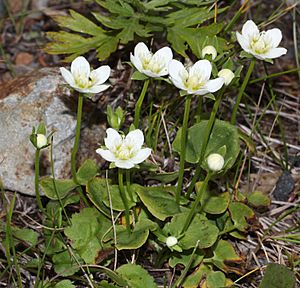Marsh grass of Parnassus facts for kids
Quick facts for kids Marsh grass of Parnassus |
|
|---|---|
 |
|
| Scientific classification | |
| Genus: |
Parnassia
|
| Species: |
palustris
|
 |
|
The Parnassia palustris, often called marsh grass of Parnassus or just bog star, is a beautiful flowering plant. It belongs to the staff-vine family, known as Celastraceae.
This special plant is the county flower of Cumberland in England. You can even see it on the flag of that area!
Its interesting name comes from ancient Greece. People believed that cattle on Mount Parnassus loved to eat this plant. So, they called it an "honorary grass." The second part of its scientific name, palustris, is Latin for "of the marsh." This tells us where it likes to grow. A Greek doctor named Dioscorides first described this plant in the 1st century A.D.
Contents
What Does the Bog Star Look Like?
Even though it's called "grass of Parnassus," this plant is not actually a grass. It doesn't even look like one! It grows from a short stem hidden underground.
Leaves and Stems
The plant has long leaves shaped like hearts. These leaves can grow to be about 4 to 12 inches (10 to 30 cm) long. In the middle of these leaves, a single flowering stem grows upwards.
Flowers and Pollinators
Each stem holds one pretty white flower. These flowers usually bloom between July and October. The flower has five stamens (the parts that hold pollen) in its center. The flower also makes a sweet, honey-like smell. This scent helps to attract pollinators, like bees, to help the plant make seeds.
Where Does the Marsh Grass of Parnassus Grow?
The Parnassia palustris plant is found in cooler, northern parts of Europe and Asia. In the United Kingdom, you can spot it in wet moorlands and marshes. It is common in northern England and Scotland.
How Was This Plant Used in the Past?
Long ago, people used the marsh grass of Parnassus in herbal medicines. They believed it could help with problems related to the liver.
Traditional Remedies
- An infusion (like a tea) made from the leaves was used to help with indigestion.
- Some people also believed that adding the leaves to wine or water could help to dissolve kidney stones.
See Also
- In Spanish: Hepática blanca para niños


